 Teachers typically celebrate poetry during the month of April, but every month, week, and day can offer inspiration for poetry. It doesn’t have to be relegated to one month each year or a poetry unit taught during one grading period. With its wide variety of forms and subjects, poetry is for every day of the year, and teachers won’t find it hard to find poems that fit all their curricular needs. Whether through reading, writing or listening to others perform poetry, there are many ways that teachers can involve their students in its appreciation. ReadWriteThink offers a plethora of lesson ideas for poetry across the grade levels.
Teachers typically celebrate poetry during the month of April, but every month, week, and day can offer inspiration for poetry. It doesn’t have to be relegated to one month each year or a poetry unit taught during one grading period. With its wide variety of forms and subjects, poetry is for every day of the year, and teachers won’t find it hard to find poems that fit all their curricular needs. Whether through reading, writing or listening to others perform poetry, there are many ways that teachers can involve their students in its appreciation. ReadWriteThink offers a plethora of lesson ideas for poetry across the grade levels.  Readers might be interested in checking out these poetry resources too: Poetry for Children Blog and the J. Patrick Lewis: Children’s Poet Laureate website as well as even more on this talented and prolific poet at www.jpatricklewis.com.
Readers might be interested in checking out these poetry resources too: Poetry for Children Blog and the J. Patrick Lewis: Children’s Poet Laureate website as well as even more on this talented and prolific poet at www.jpatricklewis.com.
For this week’s review column, members of the Children's Literature and Reading Special Interest Group (CL/R SIG) identify several books of poetry that will add fun to the summer months and inspire teachers to make poetry an integral part of the curriculum.
PRESCHOOL/INFANTS
Yolen, Jane. (2013). Wee rhymes: Baby’s first poetry book. Illus. by Jane Dyer. New York: Simon & Schuster Publishing/ Paula Wiseman Books.
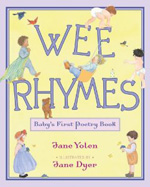 For preschools, shower gifts, or new families, this first book of poetry is just right to start young children on the path to appreciating beautiful language. The book’s author and illustrator have joined forces to create a lovely little volume of new poems, Mother Goose rhymes, songs and rhythms that fit into the everyday life of young children. Opening with the quote, “We both believe that literature begins in the cradle,” Yolen and Dyer have given a great start for anyone interested in sharing simple poems with a loved one with this marvelous lap book of poetry. Readers may be interested in some of the grandmotherly backstory at the blog, Randomly Reading. Read more about Jane Yolen and J. Patrick Lewis in this Engage blog 5 Questions interview.
For preschools, shower gifts, or new families, this first book of poetry is just right to start young children on the path to appreciating beautiful language. The book’s author and illustrator have joined forces to create a lovely little volume of new poems, Mother Goose rhymes, songs and rhythms that fit into the everyday life of young children. Opening with the quote, “We both believe that literature begins in the cradle,” Yolen and Dyer have given a great start for anyone interested in sharing simple poems with a loved one with this marvelous lap book of poetry. Readers may be interested in some of the grandmotherly backstory at the blog, Randomly Reading. Read more about Jane Yolen and J. Patrick Lewis in this Engage blog 5 Questions interview.
- Karen Hildebrand, Ohio Library and Reading Consultant
GRADES K-2
Brown, Calef. (2013). We go together! A curious selection of affectionate verse. Boston: Houghton Mifflin Books for Children.
 With Brown’s signature whimsical acrylic illustrations and lively poetics, he has created a book of poetry about friendship and things that go together or as the subtitle suggests, “a curious selection of affectionate verse.” One of the opening poems, We Go Together, sets the tone for the 14 poems within the book: “We go together/ like fingers and thumbs./Basses and drums./ Pastries and crumbs/ We go together/ like apples and plums./ Molars and gums/ Genuine chums/ …" (p.1) This will be a great book to look at metaphor and simile or to celebrate the joy of friends. Readers can get to know this author/illustrator through the video filmed at the National Book Festival.
With Brown’s signature whimsical acrylic illustrations and lively poetics, he has created a book of poetry about friendship and things that go together or as the subtitle suggests, “a curious selection of affectionate verse.” One of the opening poems, We Go Together, sets the tone for the 14 poems within the book: “We go together/ like fingers and thumbs./Basses and drums./ Pastries and crumbs/ We go together/ like apples and plums./ Molars and gums/ Genuine chums/ …" (p.1) This will be a great book to look at metaphor and simile or to celebrate the joy of friends. Readers can get to know this author/illustrator through the video filmed at the National Book Festival.
- Karen Hildebrand, Ohio Library and Reading Consultant
Fitch, Sheree. (2013). Night sky wheel ride. Illus. by Yayo. Vancouver, BC: Tradewind Books.
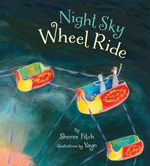 Finally old enough to ride the intriguing Ferris wheel at the carnival, Brother and Sister are off to the fairgrounds for the long-awaited ride on the wheel that seems to touch the sky. The ride at night is even more exciting as the children reach toward the stars. Lively free verse writing and cotton candy illustrations match the wordplay that makes the fascination of this ride on a giant wheel come to life. In fact, the poems begin to transform the Ferris wheel into many imaginary things as the children whirl around sounding like a giant pig that squeals “Wheeeeeeel, Wheeeeeeel,” or a spinning, spiraling washing machine or an apple tree that lets the riders plummet back to earth. The excitement and thrill of each poem will make this a delight to read aloud. Learn more about this Canadian author at her website and blog.
Finally old enough to ride the intriguing Ferris wheel at the carnival, Brother and Sister are off to the fairgrounds for the long-awaited ride on the wheel that seems to touch the sky. The ride at night is even more exciting as the children reach toward the stars. Lively free verse writing and cotton candy illustrations match the wordplay that makes the fascination of this ride on a giant wheel come to life. In fact, the poems begin to transform the Ferris wheel into many imaginary things as the children whirl around sounding like a giant pig that squeals “Wheeeeeeel, Wheeeeeeel,” or a spinning, spiraling washing machine or an apple tree that lets the riders plummet back to earth. The excitement and thrill of each poem will make this a delight to read aloud. Learn more about this Canadian author at her website and blog.
- Karen Hildebrand, Ohio Library and Reading Consultant
Fandel, Jennifer. (2012). You can write cool poems. North Mankato, MN: Capstone Press.
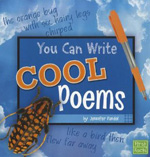 From the You Can Write series, this guidebook offers writing help for young readers and writers. Starting with ideas to tie in thoughts and feelings and turn them into words and phrases, the book offers these suggestions and then advice on how to practice some more for follow-up. Using bright colored photographs, Fast Fact boxes, writing tips and a question format, these suggestions will guide young writers and their ideas into writing poems of their own.
From the You Can Write series, this guidebook offers writing help for young readers and writers. Starting with ideas to tie in thoughts and feelings and turn them into words and phrases, the book offers these suggestions and then advice on how to practice some more for follow-up. Using bright colored photographs, Fast Fact boxes, writing tips and a question format, these suggestions will guide young writers and their ideas into writing poems of their own.
- Karen Hildebrand, Ohio Library and Reading Consultant
Gerber, Carole. (2013). Seeds, bees, butterflies and more!: Poems for two voices. Illus. by Eugene Yelchin. New York: Henry Holt and Co.
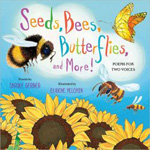 What is more fun than a poem? A poem that needs two voices! Using insects and plants for the backdrop, author Carole Gerber has created these 18 wonderful nature poems, full of facts, to be shared by two voices – perfect for classroom use and a bit of poetry performance. Gerber’s earlier book, Winter Trees (Charlesbridge, 2008), was named an Outstanding Science Trade Book, and she to blend science and poetry in her latest book with poems such as “Honey and Bumble,” which subtly voices the difference between the two types of bees: “ I like your black and yellow suit/ I love your tiny waist. Next to you,/ I’m awkward and I take up too much space./ Bumble, you’re a perfect bee/ Thanks, Honey, so are you/ Want to share my flower? There’s room enough for two!/” (unpaged). Visit the author’s website to learn about her school visits and free books.
What is more fun than a poem? A poem that needs two voices! Using insects and plants for the backdrop, author Carole Gerber has created these 18 wonderful nature poems, full of facts, to be shared by two voices – perfect for classroom use and a bit of poetry performance. Gerber’s earlier book, Winter Trees (Charlesbridge, 2008), was named an Outstanding Science Trade Book, and she to blend science and poetry in her latest book with poems such as “Honey and Bumble,” which subtly voices the difference between the two types of bees: “ I like your black and yellow suit/ I love your tiny waist. Next to you,/ I’m awkward and I take up too much space./ Bumble, you’re a perfect bee/ Thanks, Honey, so are you/ Want to share my flower? There’s room enough for two!/” (unpaged). Visit the author’s website to learn about her school visits and free books.
- Karen Hildebrand, Ohio Library and Reading Consultant
Lewis, J. Patrick. (2013). World Rat Day: Poems about real holidays you’ve never heard of. Illus. by Anna Raff. Somerville, MA: Candlewick Press.
 Acclaimed poet J. Patrick Lewis serves up 26 poems celebrating, of all things, strange holidays in honor of mules, rats, sloths, skunks, turtles, and even cephalopods. Readers can find a holiday celebrating just about anything worth celebrating, and Lewis pays tribute to all of these events in his usual slyly clever fashion. Sure to be a favorite of sweet lovers around the world, his poem "Chocolate-Covered Ants" honors Chocolate-Covered Anything Day, which makes the imagination go wild at all the chocolate possibilities. The poet includes couplets and concrete poetry as well as his typical word play in some of the lines. An unquestionable favorite one is the brief but apt "No one will ever forget Ewe" (p. 28). Yes, that's the title and the entire poem too. The poems and the illustrations, created from ink wash and drawings and then digitally assembled, speak for themselves. Young readers will enjoy these simple but effective lines and laugh at the strange types of holidays being highlighted. Back matter telling a bit more about these holidays would round this collection out nicely, but curious readers may be tempted to research them for themselves.
Acclaimed poet J. Patrick Lewis serves up 26 poems celebrating, of all things, strange holidays in honor of mules, rats, sloths, skunks, turtles, and even cephalopods. Readers can find a holiday celebrating just about anything worth celebrating, and Lewis pays tribute to all of these events in his usual slyly clever fashion. Sure to be a favorite of sweet lovers around the world, his poem "Chocolate-Covered Ants" honors Chocolate-Covered Anything Day, which makes the imagination go wild at all the chocolate possibilities. The poet includes couplets and concrete poetry as well as his typical word play in some of the lines. An unquestionable favorite one is the brief but apt "No one will ever forget Ewe" (p. 28). Yes, that's the title and the entire poem too. The poems and the illustrations, created from ink wash and drawings and then digitally assembled, speak for themselves. Young readers will enjoy these simple but effective lines and laugh at the strange types of holidays being highlighted. Back matter telling a bit more about these holidays would round this collection out nicely, but curious readers may be tempted to research them for themselves.
- Barbara A. Ward, Washington State University Pullman
Swinburne, Stephen R. (2010). Ocean soup: Tide-pool poems. Illus. by Mary Peterson. Watertown, MA: Charlesbridge.
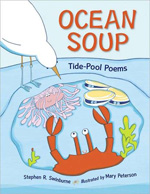 Science and poetry have become new best friends as the poet proves with his tide pool poetry. A perfect companion for any study of the ocean or visit to the beach, poems include factual information about hermit crabs, lobsters, sea slugs, sea urchins, starfish, anemone, barnacles and more marine critters. Cartoon-like illustrations will appeal to young readers as they explore the shore with these lighthearted verses that are also filled with facts. This book has its own website that includes a short video with the author, videos about some of the other poems, and numerous facts about tide pools and oceans.
Science and poetry have become new best friends as the poet proves with his tide pool poetry. A perfect companion for any study of the ocean or visit to the beach, poems include factual information about hermit crabs, lobsters, sea slugs, sea urchins, starfish, anemone, barnacles and more marine critters. Cartoon-like illustrations will appeal to young readers as they explore the shore with these lighthearted verses that are also filled with facts. This book has its own website that includes a short video with the author, videos about some of the other poems, and numerous facts about tide pools and oceans.
- Karen Hildebrand, Ohio Library and Reading Consultant
GRADES 3-5
Argueta, Jorge. (2013). Tamalitos: una poema de cocinar/A cooking poem. Trans. by Elisa Amado. Illus. by Domi. Toronto, ON: Groundwood Books.
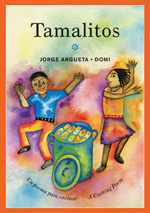 Filled with delicious words and phrases ("The husk will be like/ a little sheet for the dough" (unpaged) and "...you have a little dough package./ The dough is like a little pillow/ in the middle of the husk" (unpaged), this poem celebrates the delights of cooking tamalitos. Part recipe and cookbook and part history lesson about corn and all parts deliciously delightful, the poem provides step by step directions that are guaranteed to send just about anyone to the family kitchen. What is most interesting about this author and his book-length poem celebrating food and cooking is just how involved in the process his two characters are. For the poet and his characters, cooking little tamales requires concentration and focusing all the senses on the process. The watercolor illustrations add immeasurably to the joy of cooking, and will leave readers licking their fingers and lips and saying, “Yummmmmmy!”
Filled with delicious words and phrases ("The husk will be like/ a little sheet for the dough" (unpaged) and "...you have a little dough package./ The dough is like a little pillow/ in the middle of the husk" (unpaged), this poem celebrates the delights of cooking tamalitos. Part recipe and cookbook and part history lesson about corn and all parts deliciously delightful, the poem provides step by step directions that are guaranteed to send just about anyone to the family kitchen. What is most interesting about this author and his book-length poem celebrating food and cooking is just how involved in the process his two characters are. For the poet and his characters, cooking little tamales requires concentration and focusing all the senses on the process. The watercolor illustrations add immeasurably to the joy of cooking, and will leave readers licking their fingers and lips and saying, “Yummmmmmy!”
- Barbara A. Ward, Washington State University Pullman
Lesynski, Loris. (2012). Crazy about soccer! Illus. by Gerry Rasmussen. Toronto,ON: Annick Press.
 With cartoon-like illustrations, this book of poetry about soccer is ideal for devoted fans, whether on the field or off. Fans will be engaged from the title poem, "Crazy About Soccer" with its description of "muscles deflated/legs like spaghetti/cleats full of mud/exhausted and sweaty/sometimes a good game/ sometimes the worst/ we're tired and grimy/ and dying of thirst/ but back here tomorrow?/ you bet/ and we'll play/ day after day after day/after day" (p. 5). The history of soccer from Shakespeare to World Cup soccer is covered through these rhymed verses. Young sports enthusiasts might even enjoy a romp with these poems and a soccer ball. Teachers might be interested in introducing some of the poems with this pdf. from the publisher or they can visit the illustrator's website for more enlarged versions of the poems.
With cartoon-like illustrations, this book of poetry about soccer is ideal for devoted fans, whether on the field or off. Fans will be engaged from the title poem, "Crazy About Soccer" with its description of "muscles deflated/legs like spaghetti/cleats full of mud/exhausted and sweaty/sometimes a good game/ sometimes the worst/ we're tired and grimy/ and dying of thirst/ but back here tomorrow?/ you bet/ and we'll play/ day after day after day/after day" (p. 5). The history of soccer from Shakespeare to World Cup soccer is covered through these rhymed verses. Young sports enthusiasts might even enjoy a romp with these poems and a soccer ball. Teachers might be interested in introducing some of the poems with this pdf. from the publisher or they can visit the illustrator's website for more enlarged versions of the poems.
- Karen Hildebrand, Ohio Library and Reading Consultant
Lewis, J. Patrick. (2013). Face bug: Poems. Photographs by Frederic B. Siskind. Illus. by Kelly Murphy. Honesdale, PA: Boyds Mills Press/Wordsong.
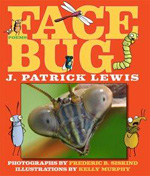 Poet J. Patrick Lewis, photographer Frederic B. Siskind and illustrator Kelly Murphy have combined talents to invite young readers to the Face Bug Museum that offers humorous verse coupled with black-and-white line illustrations and close-up photomicrographs of 14 different bugs. Enter the tree that houses the museum for a closer look at bugs like the Hickory Horned Devil, the Eastern Carpenter Bee, the Nursery Web Spider, the Pear Crescent Butterfly, the Dogday Harvestfly Cicada, the American Horse Fly, the Goldenrod Stowaway Moth, the Green Stinkbug and more. Once again, science meets poetry in an entertaining and informative way. Science poetry ideas can be found at the Growing with Science blog that features this book. Visit the author’s website for tips and tools for writing poetry.
Poet J. Patrick Lewis, photographer Frederic B. Siskind and illustrator Kelly Murphy have combined talents to invite young readers to the Face Bug Museum that offers humorous verse coupled with black-and-white line illustrations and close-up photomicrographs of 14 different bugs. Enter the tree that houses the museum for a closer look at bugs like the Hickory Horned Devil, the Eastern Carpenter Bee, the Nursery Web Spider, the Pear Crescent Butterfly, the Dogday Harvestfly Cicada, the American Horse Fly, the Goldenrod Stowaway Moth, the Green Stinkbug and more. Once again, science meets poetry in an entertaining and informative way. Science poetry ideas can be found at the Growing with Science blog that features this book. Visit the author’s website for tips and tools for writing poetry.
- Karen Hildebrand, Ohio Library and Reading Consultant
Lewis, J. Patrick, editor. (2012). National Geographic book of animal poetry: With favorites from Robert Frost, Jack Prelutsky, Emily Dickinson, and more: 200 poems with photographs that squeak, soar and roar! Washington, D.C., National Geographic.
 Even the most reluctant readers of poetry will find something appealing in this collection of 200 poems about animals by classic and contemporary writers. Selected by Children's Poet Laureate and recipient of the NCTE Excellence in Poetry for Children Award, J. Patrick Lewis, the book contains verses from Emily Dickinson, D. H. Lawrence, Ogden Nash, and Rudyard Kipling, among others, representing the past, and Paul Janeczko, Alice Schertle, Jack Prelutsky, and Janet Wong, representing the present and future of children's poetry. Lewis himself contributed a couple of delightful poems: "Polar Bear Rap" and "A Flamingo Is," attesting to his versatility. The poems have been grouped in ways that may surprise readers and prompt reflection about the animals’ commonalities in sections such as "Welcome to the World," "The Big Ones," "The Little Ones," "The Winged Ones," "The Water Ones," "The Strange Ones," "The Noisy Ones," "The Quiet Ones," and then "Final Thoughts." The poems have been placed across vivid one- and two-page photographic spreads depicting the animals being celebrated poetically. It’s hard to decide whether the poems or the images are more delightful. Teachers will appreciate the directions for writing animal poetry in the back matter as well as the resource list of books containing exemplary types of wordplay including anagrams, shaped poems, and tongue twisters. This is a book to savor and to read more than once. It's also a book that must be shared with others. Although the text credits indicate which poems were commissioned expressly for this collection and how many were previously published, it would be helpful to have that information more readily available. Still, this is a must-have for the classroom library.
Even the most reluctant readers of poetry will find something appealing in this collection of 200 poems about animals by classic and contemporary writers. Selected by Children's Poet Laureate and recipient of the NCTE Excellence in Poetry for Children Award, J. Patrick Lewis, the book contains verses from Emily Dickinson, D. H. Lawrence, Ogden Nash, and Rudyard Kipling, among others, representing the past, and Paul Janeczko, Alice Schertle, Jack Prelutsky, and Janet Wong, representing the present and future of children's poetry. Lewis himself contributed a couple of delightful poems: "Polar Bear Rap" and "A Flamingo Is," attesting to his versatility. The poems have been grouped in ways that may surprise readers and prompt reflection about the animals’ commonalities in sections such as "Welcome to the World," "The Big Ones," "The Little Ones," "The Winged Ones," "The Water Ones," "The Strange Ones," "The Noisy Ones," "The Quiet Ones," and then "Final Thoughts." The poems have been placed across vivid one- and two-page photographic spreads depicting the animals being celebrated poetically. It’s hard to decide whether the poems or the images are more delightful. Teachers will appreciate the directions for writing animal poetry in the back matter as well as the resource list of books containing exemplary types of wordplay including anagrams, shaped poems, and tongue twisters. This is a book to savor and to read more than once. It's also a book that must be shared with others. Although the text credits indicate which poems were commissioned expressly for this collection and how many were previously published, it would be helpful to have that information more readily available. Still, this is a must-have for the classroom library.
- Barbara A. Ward, Washington State University Pullman
Medina, Tony. (2013). The President looks like me: & other poems. East Orange, NJ: Just Us Books.
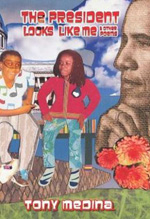 The voices of urban children ring out in these 44 multicultural poems by award-winning poet and professor, Tony Medina. The poems speak to hopes and dreams of children for their futures but also to their everyday lives and experiences. Also included are poems about famous people like musicians John Coltrane and Celia Cruz. Being Black and Latino, author Tony Medina is able to write from a truly multicultural reference point, and his poems reflect his background. The afterword offers readers a look at some of the forms of poetry used in the book including blues poems, haiku, limericks, sonnets, odes, praise poems, list poems and more. Listen to the author discuss his new book and possibilities of a Skype visit on the BlogTalkRadio interview. See more multicultural texts for children in the CL/R SIG's multicultural book reviews from April 17.
The voices of urban children ring out in these 44 multicultural poems by award-winning poet and professor, Tony Medina. The poems speak to hopes and dreams of children for their futures but also to their everyday lives and experiences. Also included are poems about famous people like musicians John Coltrane and Celia Cruz. Being Black and Latino, author Tony Medina is able to write from a truly multicultural reference point, and his poems reflect his background. The afterword offers readers a look at some of the forms of poetry used in the book including blues poems, haiku, limericks, sonnets, odes, praise poems, list poems and more. Listen to the author discuss his new book and possibilities of a Skype visit on the BlogTalkRadio interview. See more multicultural texts for children in the CL/R SIG's multicultural book reviews from April 17.
- Karen Hildebrand, Ohio Library and Reading Consultant
Service, Robert. (2013). The Cremation of Sam McGee: The 20th anniversary edition. Illus. by Ted Harrison. Toronto, ON: Kids Can Press.
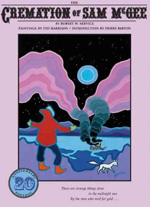 Kids Can Press has published a 20th anniversary edition of the classic poem and tale of the Yukon prospector, Sam McGee, based on their 1986 edition. Illustrator Ted Harrison has added notes on each page to add the historical background and understanding for this narrative poem. Teachers can use this video of country music great, Johnny Cash, reading The Cremation of Sam McGee or for more background information listen to this NPR discussion of the poem. Teachers might also enjoy using this detailed teaching guide to the poem.
Kids Can Press has published a 20th anniversary edition of the classic poem and tale of the Yukon prospector, Sam McGee, based on their 1986 edition. Illustrator Ted Harrison has added notes on each page to add the historical background and understanding for this narrative poem. Teachers can use this video of country music great, Johnny Cash, reading The Cremation of Sam McGee or for more background information listen to this NPR discussion of the poem. Teachers might also enjoy using this detailed teaching guide to the poem.
- Karen Hildebrand, Ohio Library and Reading Consultant
Singer, Marilyn. (2013). Follow, follow: A book of reverso poems. Illus. by Josee Masse. New York: Dial Books for Young Readers.
 Following her successful and original Mirror, Mirror (Dutton, 2010), Marilyn Singer has written a second book based on fairy tales using the reverso format where the poems are presented forward and backward. For example, in this new edition from the tale of “The Emperor’s New Clothes,” comes Singer’s “The Birthday Suit” (p.5): “Behold his glorious majesty:/me,/Who dares say he drained the treasury/on/nothing?/Ha!/This emperor has/sublime taste in finery!/ Only a fool could fail to see./ Now read the verso poem of the same tale: “Only a fool could fail to see./Sublime taste in finery?/This emperor has-/ha!/nothing/on!/Who dares say he drained the treasury?/Me./Behold his glorious majesty!/ From “The Little Mermaid’s Choice” to “Your Wish is my Command” to “The Silly Goose,” Singer has cleverly created poems that beg to be read aloud with two voices, punctuation emphasis and perhaps a theatric or two for a truly enjoyable poetry experience. Teachers can visit Marilyn Singer’s website to learn more about her work.
Following her successful and original Mirror, Mirror (Dutton, 2010), Marilyn Singer has written a second book based on fairy tales using the reverso format where the poems are presented forward and backward. For example, in this new edition from the tale of “The Emperor’s New Clothes,” comes Singer’s “The Birthday Suit” (p.5): “Behold his glorious majesty:/me,/Who dares say he drained the treasury/on/nothing?/Ha!/This emperor has/sublime taste in finery!/ Only a fool could fail to see./ Now read the verso poem of the same tale: “Only a fool could fail to see./Sublime taste in finery?/This emperor has-/ha!/nothing/on!/Who dares say he drained the treasury?/Me./Behold his glorious majesty!/ From “The Little Mermaid’s Choice” to “Your Wish is my Command” to “The Silly Goose,” Singer has cleverly created poems that beg to be read aloud with two voices, punctuation emphasis and perhaps a theatric or two for a truly enjoyable poetry experience. Teachers can visit Marilyn Singer’s website to learn more about her work.
- Karen Hildebrand, Ohio Library and Reading Consultant
Vardell, Sylvia, & Wong, Janet. (2013). The Poetry Friday anthology for middle school: Poems for the school year with connections to the Common Core: Middle School Edition. Princeton, NJ: Pomelo Books.
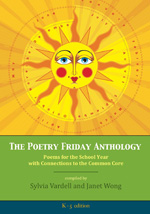 The end of school and approach of summer are perfect times for teachers to recharge their emotional and intellectual batteries and consider adding poetry to their daily instructional routine for the coming school year. Shaking a dash of poetry into the instructional mix makes any lesson far from mundane. Savvy teachers have learned they can trust Vardell and Wong, both former members of the NCTE Excellence in Poetry for Children Award Committee, to guide them as they choose poems to share with their students. As in their previous title, The Poetry Anthology K-5 Edition (2012), the compilers have selected 108 poems, 36 for each grade level, in order to provide teachers with a poem for each week. Each week has a theme that goes across all grade levels, enabling teachers to choose other poems or for students at various grade levels to enjoy poems on similar topics. Even the most reluctant performer will feel supported by the Take 5! box that accompanies every poem. These carefully chosen tips and strategies offer ways to present the poems through art, drama, and technology and describe curriculum connections. Since the tips follow a particular format, they are easy to follow and are likely to entice teachers (or their students) to try them. The first tip suggests ways to enliven the poem through props, gestures, and expressive reading. The second tip provides ways to involve the students by reading aloud repeated lines or chosen words. The third tip offers a simple but engaging open-ended discussion prompt about the poem. The fourth tip is essentially a poetry primer since the authors connect the poem for the week to a poetic concept or language arts skill. Finally, the fifth tip suggests additional poems or poetry books that relate to the provided poem and can extend the lesson even further. Considered separately, each tip scaffolds teachers’ approach to the poetry, but taken together, these tips provide abundant resources for building cross-curricular, poetry-based middle grade classrooms that take note of the social nature of learning. Teachers will be hard pressed to decide whether they love the poems, written expressly for this book by poets such as Leslie Bulion, Guadalupe Garcia McCall, Heidi Mordhorst, Laura Purdie Salas, Joyce Sidman, Allan Wolf, and Jane Yolen, among others, or the teaching tips the best. Whatever their preference may be, they will find this book to be THE essential resource for allowing poetry to assume its rightful, thoughtful place in today’s classroom. With Vardell and Wong and this resource by their sides, teachers will be compelled to perform poetry and share their newly-awakened passion for poetry with their own students. It’s a sure bet that their middle graders will clamor to perform some of the poems in their own inimitable ways. Innovative teachers can count on this resource to enliven their classrooms. Write on, Sylvia and Janet, write on!
The end of school and approach of summer are perfect times for teachers to recharge their emotional and intellectual batteries and consider adding poetry to their daily instructional routine for the coming school year. Shaking a dash of poetry into the instructional mix makes any lesson far from mundane. Savvy teachers have learned they can trust Vardell and Wong, both former members of the NCTE Excellence in Poetry for Children Award Committee, to guide them as they choose poems to share with their students. As in their previous title, The Poetry Anthology K-5 Edition (2012), the compilers have selected 108 poems, 36 for each grade level, in order to provide teachers with a poem for each week. Each week has a theme that goes across all grade levels, enabling teachers to choose other poems or for students at various grade levels to enjoy poems on similar topics. Even the most reluctant performer will feel supported by the Take 5! box that accompanies every poem. These carefully chosen tips and strategies offer ways to present the poems through art, drama, and technology and describe curriculum connections. Since the tips follow a particular format, they are easy to follow and are likely to entice teachers (or their students) to try them. The first tip suggests ways to enliven the poem through props, gestures, and expressive reading. The second tip provides ways to involve the students by reading aloud repeated lines or chosen words. The third tip offers a simple but engaging open-ended discussion prompt about the poem. The fourth tip is essentially a poetry primer since the authors connect the poem for the week to a poetic concept or language arts skill. Finally, the fifth tip suggests additional poems or poetry books that relate to the provided poem and can extend the lesson even further. Considered separately, each tip scaffolds teachers’ approach to the poetry, but taken together, these tips provide abundant resources for building cross-curricular, poetry-based middle grade classrooms that take note of the social nature of learning. Teachers will be hard pressed to decide whether they love the poems, written expressly for this book by poets such as Leslie Bulion, Guadalupe Garcia McCall, Heidi Mordhorst, Laura Purdie Salas, Joyce Sidman, Allan Wolf, and Jane Yolen, among others, or the teaching tips the best. Whatever their preference may be, they will find this book to be THE essential resource for allowing poetry to assume its rightful, thoughtful place in today’s classroom. With Vardell and Wong and this resource by their sides, teachers will be compelled to perform poetry and share their newly-awakened passion for poetry with their own students. It’s a sure bet that their middle graders will clamor to perform some of the poems in their own inimitable ways. Innovative teachers can count on this resource to enliven their classrooms. Write on, Sylvia and Janet, write on!
- Barbara A. Ward, Washington State University Pullman
Yolen, Jane, and Rebecca Kai Dotlich. (2013). Grumbles from the forest: Fairy-tale voices with a twist: Poems. Illus. by Matt Mahurin. Honesdale, PA: Boyds Mills Press/Wordsong.
 Drawing inspiration from 15 familiar fairy tales familiar to the Western world, these two talented poets offer their different takes on each tale. Sometimes in the 30 poems shared here, they introduce new characters, and sometimes they simply create lines that provide a varied perspective on the story, for instance, that of the pea smashed under those mattresses and the long-suffering princess in "The Princess and the Pea." Readers may enjoy performing "Three Bears, Five Voices" and "Goldilocks Leaves a Letter Stuck in the Door," two poems inspired, of course, by "Goldilocks and the Three Bears." The illustrations contain dark colors and scenes of violence that fit the dark, pensive nature of many of these rhymes. Teachers will want to pair this one with Singer’s earlier Mirror Mirror (Dutton, 2010), and consider using it as fodder for writing inspiration for their own students.
Drawing inspiration from 15 familiar fairy tales familiar to the Western world, these two talented poets offer their different takes on each tale. Sometimes in the 30 poems shared here, they introduce new characters, and sometimes they simply create lines that provide a varied perspective on the story, for instance, that of the pea smashed under those mattresses and the long-suffering princess in "The Princess and the Pea." Readers may enjoy performing "Three Bears, Five Voices" and "Goldilocks Leaves a Letter Stuck in the Door," two poems inspired, of course, by "Goldilocks and the Three Bears." The illustrations contain dark colors and scenes of violence that fit the dark, pensive nature of many of these rhymes. Teachers will want to pair this one with Singer’s earlier Mirror Mirror (Dutton, 2010), and consider using it as fodder for writing inspiration for their own students.
- Barbara A. Ward, Washington State University Pullman
GRADES 9-12
Bush, Gail and Randy Meyer (Ed.). (2013). Indivisible: Poems for social justice. Illus. by Matthew Bush. Chicago: Norwood House Press.
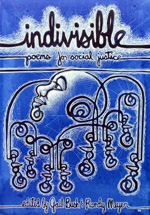 This collection of 54 poems is devoted to “living in a more socially just America,” according to the co-editors of this anthology. Poets such as Billy Collins, Pat Mora, Matthew Thomas Bush, Langston Hughes, Amiri Baraka, Ishmael Reed and more 20th century writers make this volume relevant for today’s world. This work is divided into five sections beginning with “liberty was misquoted” and goes on from there to develop concepts of freedom and equality and how teens can be moved to make change and move to action. The foreword is written by Common, a hip-hop artist, whose involvement may draw teen readers to the book. For more in this theme, read the CL/R SIG's reviews of new children's books about social justice.
This collection of 54 poems is devoted to “living in a more socially just America,” according to the co-editors of this anthology. Poets such as Billy Collins, Pat Mora, Matthew Thomas Bush, Langston Hughes, Amiri Baraka, Ishmael Reed and more 20th century writers make this volume relevant for today’s world. This work is divided into five sections beginning with “liberty was misquoted” and goes on from there to develop concepts of freedom and equality and how teens can be moved to make change and move to action. The foreword is written by Common, a hip-hop artist, whose involvement may draw teen readers to the book. For more in this theme, read the CL/R SIG's reviews of new children's books about social justice.
- Karen Hildebrand, Ohio Library and Reading Consultant
Kennedy, Caroline (Selected by). (2013). Poems to learn by heart. Paintings by Jon J Muth. New York: Disney/Hyperion Books.
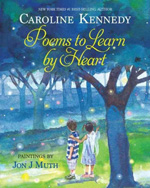 This companion to Caroline Kennedy’s A Family of Poems (2005), brings over one hundred more poems to young readers and families who appreciate life through the beauty of words in poetry. Arranged in themes like nature, sports, monsters and fairies, and friendship and family readers will find poetry old and new. Caroline Kennedy is now emphasizing the importance and depth of feeling involved in actually memorizing favorite poems and the confidence it builds when one is empowered with a poem. Moth’s watercolor paintings add to the beauty of the poetry. Listen to the NPR discussion of this book by Caroline Kennedy and the merits of memorizing poetry or watch this video with kids and Caroline.
This companion to Caroline Kennedy’s A Family of Poems (2005), brings over one hundred more poems to young readers and families who appreciate life through the beauty of words in poetry. Arranged in themes like nature, sports, monsters and fairies, and friendship and family readers will find poetry old and new. Caroline Kennedy is now emphasizing the importance and depth of feeling involved in actually memorizing favorite poems and the confidence it builds when one is empowered with a poem. Moth’s watercolor paintings add to the beauty of the poetry. Listen to the NPR discussion of this book by Caroline Kennedy and the merits of memorizing poetry or watch this video with kids and Caroline.
- Karen Hildebrand, Ohio Library and Reading Consultant
These reviews are submitted by members of the International Reading Association's Children's Literature and Reading Special Interest Group (CL/R SIG) and are published weekly on Reading Today Online. The International Reading Association partners with the National Council of Teachers of English and Verizon Thinkfinity to produce ReadWriteThink.org, a website devoted to providing literacy instruction and interactive resources for grades K–12.